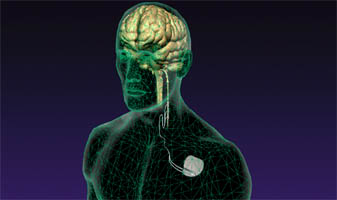Grant Enables Researchers to Continue Studying Stroke Recovery
Oct. 20, 2014

Dr. Michael Kilgard

Dr. Robert Rennaker
At UT Dallas, researchers are developing new techniques to aid recovery from stroke. Their efforts recently received a boost thanks to a multimillion-dollar grant from the National Institutes of Health.
Drs. Michael Kilgard and Robert Rennaker will receive $2.3 million over the next five years to test the effectiveness of using vagus nerve stimulation (VNS) to enhance recovery from stroke in an older population.
According to the Centers for Disease Control and Prevention, more than 795,000 people in the United States will experience a stroke every year. Survivors are often left with weakness or paralysis of their limbs.
“Things like feeding yourself, brushing your teeth, putting your clothes on by yourself — all of those things are almost impossible if you’ve lost upper limb function on one side,” said Rennaker, head of the bioengineering department and director of the Texas Biomedical Device Center at UT Dallas.
Stroke is the No. 1 cause of disability in the United States, but it is also one of the easiest neurological disorders to study because it has a clearly defined cause, according to Kilgard, the Margaret Fonde Jonsson Professor in the School of Behavioral and Brain Sciences. Other brain disorders are more difficult to study because they result from multiple breaks in the nervous system, or their origins are not fully understood, he said.
Strokes occur when blood flow to the brain is interrupted, due to either a blockage (ischemic stroke) or a ruptured blood vessel (hemorrhagic stroke). Blood normally delivers life-sustaining oxygen to the brain. But without that timely and constant delivery, the affected areas become damaged and can eventually result in disability or death to the individual.
Some recovery can occur naturally after a stroke and restore some of the lost brain function. The ability of the brain to change after a stroke is referred to as neuroplasticity. Kilgard and Rennaker are using VNS to try to enhance that neuroplasticity and increase the recovered motor function.
VNS is an FDA-approved method for treating various illnesses, such as depression and epilepsy. It involves sending a mild electric pulse through the vagus nerve, which is in the neck and relays information about the state of the body to the brain.
“We’re interested in learning what is changing in the brain as a result of the VNS therapy, and how those changes lead to recovery.”
Dr. Michael Kilgard,
the Margaret Fonde Jonsson Professor in the School of Behavioral and Brain Sciences
Recent research at UT Dallas explored the use of VNS to enhance recovery from the two types of stroke. Last year, Dr. Navid Khodaparast published research describing the complete recovery of animals’ upper limb function after an ischemic stroke. In August, Dr. Seth Hays demonstrated an improvement in recovery from a hemorrhagic stroke in rats.
The new research project will employ an animal model to examine how effective VNS therapy is in an older population. According to the American Heart Association, the risk of having a stroke approximately doubles for every decade of life over 55 years.
“We’re interested in learning what is changing in the brain as a result of the VNS therapy, and how those changes lead to recovery,” Kilgard said.
Specifically, the researchers will examine changes in dendrites, the part of nerve cells in the brain that receives signals from other neurons. They’ll focus on the motor cortex region of the brain controlling upper limb function. They predict VNS therapy might increase dendritic growth in areas of the brain involved in recovery.
Researchers also will examine the connections between the neurons across the two sides of the brain. In a healthy animal, the right side of the brain controls the left side of the body and vice versa for the other side. In an animal recovering from brain damage to one side, recovery could be due to the surrounding undamaged areas taking over the work of the damaged areas or the other side of the brain taking over. Tracing the connections will allow the researchers to see which area of the brain is taking control, providing insight into where the recovery is taking place.
“Although we focus a lot on figuring out the basic science behind why VNS therapy works, our overall goal is to eventually improve the lives of patients,” Kilgard said. “Research like this will help us do that.”
Media Contact: Ben Porter, UT Dallas, (972) 883-2193, ben.porter@utdallas.edu
or the Office of Media Relations, UT Dallas, (972) 883-2155, newscenter@utdallas.edu.

No comments:
Post a Comment